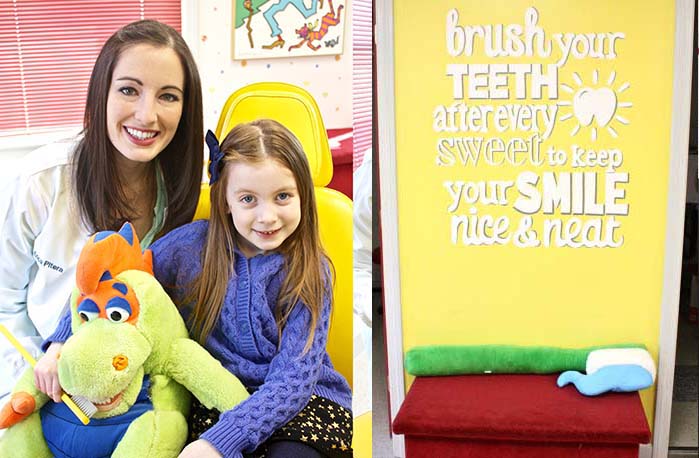Just when you’ve got your sleep schedule under control and your routine with your baby is ironed-out, teeth start showing up and throw everyone for a loop. Your normally happy baby might become a fuss bucket for no apparent reason, or all of a sudden copious amounts of drool have you replacing bibs every hour on the hour. Here are a few tips from Dr. Erica Pitera for every new parent to help be prepared for what is sometimes referred to as the “teething blues”.

1. Most babies will get their first tooth around 6 months, but some children will start teething as young as 4 months and others won’t cut a tooth until around 1 year of age! There is a huge range of what is considered normal for the timing of when baby teeth erupt as every baby grows at their own speed. As a general rule, girls tend to cut teeth earlier than boys and the pattern of teething timing tends to be hereditary too.
2. The most common symptoms of teething include excessive drooling, a rash on the face or chest, biting on hard objects, sleep disturbances, gum swelling and soreness, and general irritability. Although many parents report a fever to be associated with teething, there is no scientific evidence to support this connection so we always recommend consulting with your pediatrician if a fever persists.
3. There are several recommended methods for providing relief from teething pain for your baby. Our favorites include using frozen teething rings or a cold, moist washcloth for your baby to suck on. Gently rubbing and massaging your baby’s gums with a cold washcloth is also helpful. Mild pain relievers such as Tylenol can be beneficial before bedtime, but consult with your pediatrician or pediatric dentist if you are unsure of the proper dose.
4. Stay away from teething tablets and gels with benzocaine or belladonna (such as Anbesol or Orajel) due to the potential side effects. Although some parents swear by amber teething necklaces, there is no scientific evidence to support their effectiveness and they can pose a strangulation risk or be a potential choking hazard.
5. Once baby teeth are present in the mouth, we recommend brushing with fluoridated toothpaste twice a day. The amount of toothpaste should be TINY, like a grain of rice or just a thin smear, because we understand that infants cannot spit out the excess. Newly erupted teeth are like sponges for fluoride and the mineral will help strengthen the enamel for the lifetime of that tooth. If you notice excess toothpaste remaining on your baby’s teeth, you can use a tissue or washcloth to wipe them after brushing.
6. NEVER put your baby to bed with a bottle of milk! Babies tend to pocket milk in their mouth after they fall asleep, and even the small amounts of natural sugar found in both milk or breast milk can cause decay in baby teeth. If your baby nurses throughout the night, make sure to wipe their teeth (or ideally brush them if you can!) before putting them back to bed.
7. The American Academy of Pediatric Dentistry and the American Academy of Pediatrics recommend that your baby see a pediatric dentist by age one. Even though one year olds sometimes only have a few teeth, it is important to establish a dental home for your baby in order to receive guidance on their diet, brushing habits, fluoride intake, and a place to go in the case of dental trauma. To read more about first dental visits at our office, check out this post!

For any other questions regarding your baby’s teeth, please don’t hesitate to contact our office. Our team specializes in treating children and we pride ourselves in providing specialized care in a compassionate and friendly manner that makes both parents and children (even babies!) feel at ease. We look forward to meeting you at your baby’s first visit and don’t hesitate to request an appointment below!
Sweet Tooth Pediatric Dentistry
583 Saybrook Road
Middletown, CT 06457
(860) 347-4681
www.sweettoothkids.com
